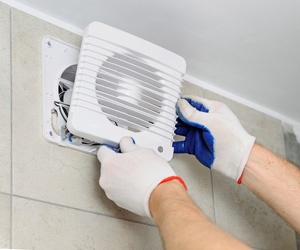 In Tallahassee, today’s energy-efficient homes are designed with tight building envelopes to keep conditioned air in and your energy bills low. This is great for reducing drafts and wasted energy. However, these same features can trap stale indoor air and pollutants inside your home.
In Tallahassee, today’s energy-efficient homes are designed with tight building envelopes to keep conditioned air in and your energy bills low. This is great for reducing drafts and wasted energy. However, these same features can trap stale indoor air and pollutants inside your home.
According to the U.S. Environmental Protection Agency (EPA) and Consumer Product Safety Commission (CPSC), indoor air pollution can be two to five times higher than outdoor levels. Without proper ventilation, pollutants from things such as cleaning products, paint, and building materials can accumulate, creating health risks for you and your family.
Indoor Air Quality in Tight Homes
Modern building practices seal our homes against air leaks. This keeps heat and cooled air where it belongs but also traps moisture and airborne toxins inside. Our everyday activities like cooking, showering, and cleaning release water vapor and volatile organic compounds (VOCs). Without ventilation, these things can build up to unhealthy levels.
Here in Florida, our high humidity levels add to the challenge. Moisture buildup can lead to mold and mildew if it is not managed. That is why the building science mantra is “build it tight; vent it right.” A sealed home gives you control over comfort and air quality, but only if you have mechanical ventilation to replace the natural leakage older homes rely on.
Florida building code requires whole-house ventilation systems for extremely airtight homes testing below three air changes per hour in a blower-door test. This makes it very important to have proper ventilation design. Creating a well-sealed, energy-efficient home with proper HVAC and vent fans will provide you better air control than a drafty home. It will keep pollutants out, remove excess moisture, and maintain healthy air.
Ventilation in Tallahassee’s Climate
 Tallahassee’s long, muggy summers make opening your windows for natural ventilation impractical. In fact, the wrong approach can cause damage. Exhaust ventilation systems pull air out of your house. In our humid climate this strategy can backfire by drawing moist air into your wall cavities. Over time, this may cause condensation, mold, or even structural problems.
Tallahassee’s long, muggy summers make opening your windows for natural ventilation impractical. In fact, the wrong approach can cause damage. Exhaust ventilation systems pull air out of your house. In our humid climate this strategy can backfire by drawing moist air into your wall cavities. Over time, this may cause condensation, mold, or even structural problems.
In contrast, supply ventilation systems push incoming fresh air into your house. This creates slight positive pressure, helping keep humid outdoor air from sneaking in through cracks. These systems allow filtering of incoming air to remove pollen and dust, and they reduce backdrafting risks with gas appliances.
For the best year-round control, balanced ventilation systems use both supply and exhaust fans to exchange air in equal amounts. Many balanced systems in Florida include heat recovery ventilators or energy recovery ventilators. An energy recovery ventilation system transfers heat and moisture between air streams. This reduces the amount of humidity entering your home and recovering energy that would otherwise be lost.
It’s important for ventilation and humidity control to work together hand-in-hand here in Florida. Many Tallahassee homeowners choose to integrate dehumidifiers into their ventilation systems.
Common Types of Home Ventilation Systems
Exhaust-Only Ventilation
These exhaust-only house ventilation systems use fans to remove stale air from your home. They are simple and inexpensive but do not control where replacement air comes from. In our humid climate, they can pull in unwanted moisture and unfiltered air from your damp crawl space or dusty attic. They are not recommended for long-term use in our hot, humid region.
Supply-Only Ventilation
Supply-only ventilation systems use a fan and duct system to deliver fresh outdoor air into your living spaces or the HVAC system return. These systems give you more control over air quality and filtration options and work well in our humid climate. You can connect the intake to your dehumidifier for air conditioning and better comfort. However, they may not remove all stale air and can raise cooling loads in summer. They also don’t remove heat or moisture from incoming air.
Balanced Ventilation
Balanced ventilation systems provide dedicated intake and exhaust, keeping air pressure neutral. They use two fans and two sets of ducts to move equal amounts of air in and out of your home. Air is supplied to your living spaces and exhausted from moisture-producing areas like kitchens and baths. These systems are designed to work well in all climates. Many local homeowners use heat recovery ventilators (HRVs) or energy recovery ventilators (ERVs) with this system for better efficiency and humidity control.
A balanced ventilation system is considered best practice for new, air-tight homes. The biggest challenges with this system though are its higher costs and complexity, and extra equipment and electricity needed to install and maintain it.
Ensuring Proper Ventilation in Your Home
 It’s important to remember that good ventilation is part of a bigger picture that includes insulation and air sealing. They work together to help create an energy-efficient, healthy home.
It’s important to remember that good ventilation is part of a bigger picture that includes insulation and air sealing. They work together to help create an energy-efficient, healthy home.
Older homes may get by with natural ventilation, yet they still suffer from both drafts and poor air quality. In new, airtight homes, mechanical ventilation is a necessity. Every home is different, and working with a local expert helps ensure your ventilation system is designed for your space, climate, and comfort needs.
Breathe Easier with Allweather Insulation
At Allweather Insulation, we know Florida homes and have been serving Tallahassee homeowners and builders since 1955. We’re here to answer all your questions about air sealing, insulation, and ventilation. We want you to have peace of mind that your home is comfortable, efficient, and healthy year-round.
Call us today to schedule your consultation and take the first step toward cleaner, fresher air in your Tallahassee home.
References
Ruppert, Kathleen C., et al. “Energy Efficient Homes: Indoor Air Quality and Energy.” EDIS, University of Florida IFAS Extension, 2019, https://edis.ifas.ufl.edu/publication/FY1044.
U.S. Consumer Product Safety Commission. The Inside Story: A Guide to Indoor Air Quality. CPSC and EPA, 2012, www.cpsc.gov/Safety-Education/Safety-Guides/Home/The-Inside-Story-A-Guide-to-Indoor-Air-Quality.
U.S. Department of Energy. “Ventilation.” Energy Saver, 21 Apr. 2025, www.energy.gov/energysaver/ventilation.
U.S. Department of Energy. “Whole-House Ventilation.” Energy Saver, https://www.energy.gov/energysaver/whole-house-ventilation.
Insulation Outlook Magazine. “Contractor’s Field Guide to the Building Envelope.” Insulation.org, Mar. 2019, https://insulation.org/io/articles/contractors-field-guide-to-the-building-envelope/.
EnergyGauge Support. “Is Mechanical Ventilation Required for Residential Florida Code Compliance?” University of Central Florida, 12 July 2024, https://support.energygauge.com/support/solutions/articles/12000100650.
Smarter House. “Whole-House Ventilation Strategies.” SmarterHouse.org, ACEEE, www.smarterhouse.org/ventilation-and-air-distribution/whole-house-ventilation-strategies.
Energy Vanguard. “Will Balanced Ventilation Be Required by Code?” EnergyVanguard.com, 16 Jan. 2023, https://www.energyvanguard.com/blog/will-balanced-ventilation-be-required-code/.

